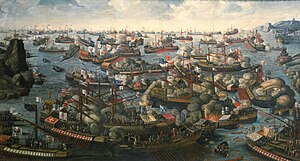
Oared vessel tactics were the dominant form of naval tactics used from antiquity to the late 16th century when sailing ships began to replace galleys and other types of oared ships as the principal form of warships. Throughout antiquity, through the Middle Ages until the 16th century, the weapons relied on were the ship itself, used as a battering ram or to sink the opponent with naval rams, the melee weapons of the crew, missile weapons such as bolts from heavy crossbows fixed on the bulwarks, bows and arrows, weights dropped from a yard or pole rigged out, and the various means of setting fire to enemy ships. The latter could be done by shooting arrows with burning tow or by Greek fire ejected through specially designed siphons.
All oared vessel actions were fought at close quarters, where ramming and boarding were possible. But the use of the ram was only available for a vessel driven by oars. While fleets depended on the methods of battle at close quarters, two conditions were imposed on the warship: light structure, so that her crew could row her with effect, and a large crew to work her oars and fight in hand-to-hand combat. Sails were available by virtually all types of galleys in long-range strategic maneuvers, and to relieve the rowers. Sails were lowered in action, however, and when the combatant had a secure port at hand, the rigging could be left ashore before battle.